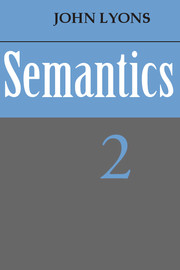Book contents
- Frontmatter
- Contents
- Figures
- Typographical conventions
- Preface
- 10 Semantics and grammar I
- 11 Semantics and grammar II
- 12 Semantics and grammar III
- 13 The Lexicon
- 14 Context, style and culture
- 15 Deixis, space and time
- 16 Mood and illocutionary force
- 17 Modality
- Bibliography
- Index of subjects
- Index of personal names
16 - Mood and illocutionary force
Published online by Cambridge University Press: 05 June 2012
- Frontmatter
- Contents
- Figures
- Typographical conventions
- Preface
- 10 Semantics and grammar I
- 11 Semantics and grammar II
- 12 Semantics and grammar III
- 13 The Lexicon
- 14 Context, style and culture
- 15 Deixis, space and time
- 16 Mood and illocutionary force
- 17 Modality
- Bibliography
- Index of subjects
- Index of personal names
Summary
Speech-acts
Throughout much of this book so far we have been mainly concerned with the descriptive function of language: i.e. with the way language is used to make statements. But language also serves as an instrument for the transmission of other kinds of information. Not all the utterances we produce are statements; and statements, as well as questions, commands, requests, exclamations, etc., will contain a certain amount of nondescriptive information, which may be characterized, broadly, as expressive (or indexical) and social (cf. 2.4). Furthermore, the transmission of descriptive information is not usually an end in itself. When we communicate some proposition to another person, we do so, normally, because we wish to influence in some way his beliefs, his attitudes or his behaviour.
To produce an utterance is to engage in a certain kind of social interaction. This is a fact that, until recently, logicians and philosophers of language have tended to overlook, though it has often been stressed by linguists, psychologists, sociologists and anthropologists. One of the most attractive features of the theory of speech-acts, which was introduced into the philosophy of language by J. L. Austin, is that it gives explicit recognition to the social or interpersonal dimension of language-behaviour and provides a general framework, as we shall see, for the discussion of the syntactic and semantic distinctions that linguists have traditionally described in terms of mood and modality.
Information
- Type
- Chapter
- Information
- Semantics , pp. 725 - 786Publisher: Cambridge University PressPrint publication year: 1977
Accessibility standard: Unknown
Why this information is here
This section outlines the accessibility features of this content - including support for screen readers, full keyboard navigation and high-contrast display options. This may not be relevant for you.Accessibility Information
- 1
- Cited by
